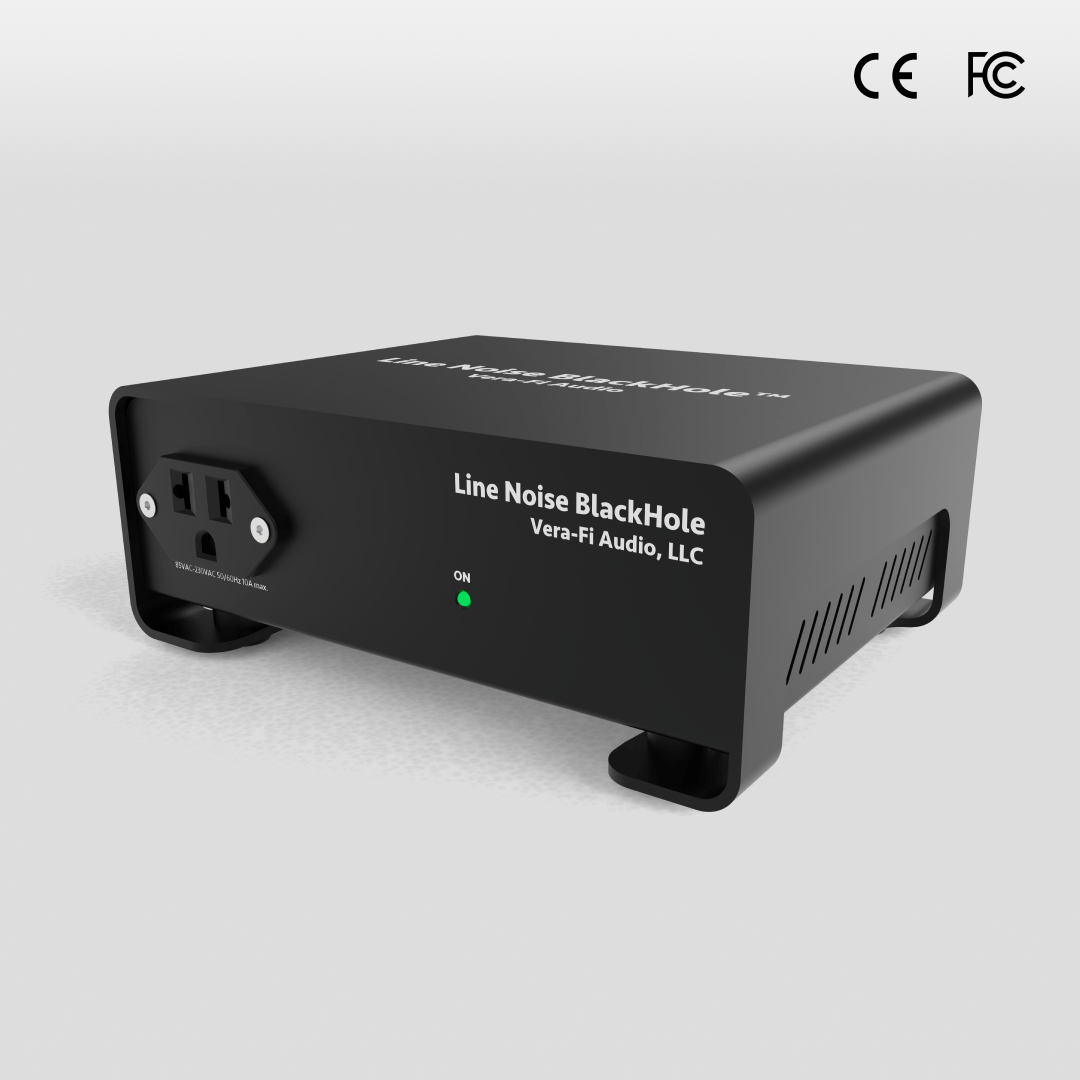Vera-Fi Audio LLC
Line Noise BlackHole
Line Noise BlackHole
Couldn't load pickup availability
Recommended Plug Adapters
Recommended Plug Adapters
The Snub Station Zero, Infinity Fuse and Line Noise Black Hole do not support 3-Prong Schuko with grounding pins currently.
But just in case you need grounding, here are adapters we recommend for you to use:
Product Description
Product Description
The Line Noise BlackHole (LNBH) is a compact, plug-and-play EMI/RFI sink filter designed to passively clean up noisy AC lines. No current limitation, no sonic compression—just quieter backgrounds and more revealing sound.
The Power Noise Problem
Power lines today carry more than voltage—they carry noise. Routers, chargers, appliances, and dimmers inject electromagnetic interference into the AC line. This affects the transparency, dynamics, and clarity of your audio system.
How the BlackHole Works
The Line Noise BlackHole (LNBH) connects in series to your circuit and absorbs high-frequency EMI/RFI through a computer-optimized 5th order Chebyshev filter network that achieves >50dB attenuation of noise above 100kHz.
Because it is a series-filter, it is very effective at scrubbing out noise, like a black hole -- the noise goes in, but it doesn't come out. It can provide up to 10A of current for your devices and it will filter out high frequency noise from switch mode power supplies and other noise sources to make the "blacks even blacker"
No Power Restriction, All Gain
Plug the LNBH in between the wall plug and your system and it cleans the entire line downstream.
Plug the LNBH into any unused wall or power strip outlet on the same circuit as your system. It cleans the entire line—without restricting current flow to your components.
Real-World Results You Can Hear
When installed correctly, it's designed to deliver:
- Lower background noise
- Sharper imaging
- Improved microdetail and texture
- A more natural, relaxed sound
It doesn’t color the sound. It clears the path.
Technical Specs and Safety
- Voltage Range: 85–230V AC / 10A
- Certifications: CE / FCC / RoHS / REACH
- Construction: IEC inlet + fused switch + NEMA outlet
- LED Indicator: Green glow confirms power is active
Safe for most HiFi systems, not suitable for medical equipment or high-leakage circuits.
Set It and Forget It
Once plugged in, the Line Noise BlackHole works silently in the background. Add more units across your home for cumulative noise reduction. It's the easiest upgrade you'll ever hear.
The Line Noise BlackHole is designed in the USA and assembled in China using only premium-quality components.
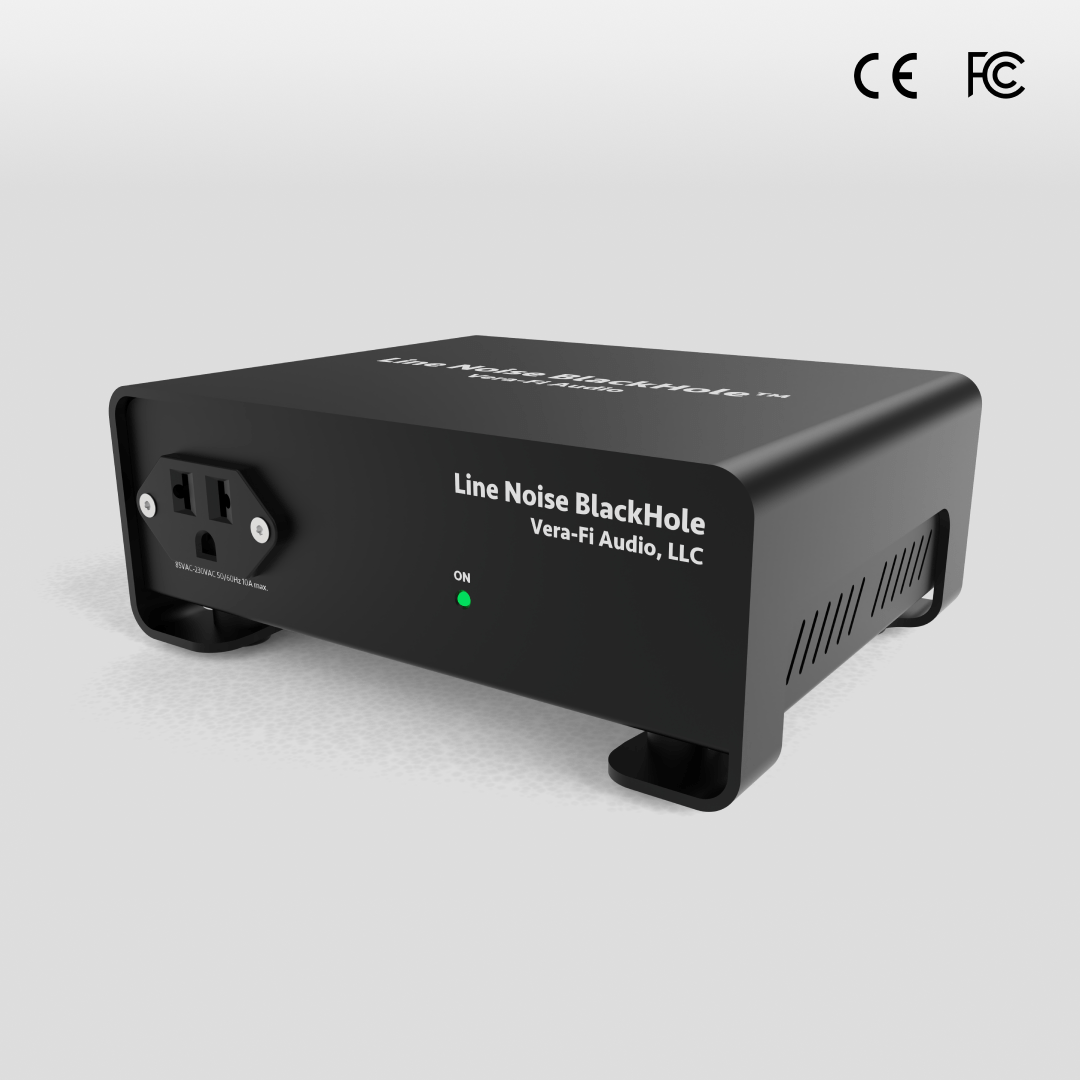
Awesome little device. Lowest noise floor I’ve heard in my system and without the expense of dynamics. Like my old Running Springs power conditioner it expands dynamics instead of suppressing them but the backgrounds are even blacker and at less than a tenth of the price. Well done
The LNBH attached to my streamer made things quieter. I suppose reduced noise I didn’t know was there.
Mark, it's been nearly a week since all three of the components I purchased (2 Line Noise Black Holes and 1 Snub Station Zero) have been in the system and I was going to hold off longer to give you a report. . . but. . . I feel they have settled in and are "being all they can be" and. . . WOW.
First off let me explain how I am using them. Previous to their arrival I had moved from using a PS Audio P15 (with a Swiss Digital Fuse Box) to a Decware Zen Line Conditioner (with no Swiss Digital Fuse Box) as the P15 failed and will soon be on the way to PS Audio for a repair. This was not as big a "step down" as I had feared and I liked the sound. I had some hum (and I attributed it to my Decware ZROCK3 and SEWE300B, both of which seemed to have an inherent hum). Great sound. . . and then the three new components came in.
I put one of the Line Noise Black Holes in between the wall and the Zen Line Conditioner. Another I put coming out of the Zen Line Conditioner and out of that my Decware ZROCK3 (there is a Swiss Digital Fuse Box between the Line Noise Black Hole and the ZROCK3). A power cable from the Zen Line Conditioner went into the Snub Station Zero and into that I connected my Decware SEWE300B amplifier into the "Soft Start" receptacle (there is a Swiss Digital Fuse Box between the Snub Station Zero and the SEWE300B), my PS Audio NuWave Phono Converter and the Neo2 power supply for my Rega RP3 turntable with all the Groovetracer mods and an Exact2 cartridge into the two other receptacles. My PS Audio DSD DAC Mk II and my PS Audio SACD Transport were connected directly into the Zen Line Conditioner (there is a Swiss Digital Fuse box between the Zen Line Conditioner and the DSD Mk II).
Immediately there was lower noise overall in the system and as a result a bit more mid-range presence, mid-bass texture, and an increase in perceived dynamic presentation. I was very happy with the sound. What I found very interesting--and pleasing--was that over the next few days the "noise" seemed to diminish even more and on the fourth morning I was truly surprised to hear almost all the "hum" I had been experiencing (not audible from the listening chair) had almost completely disappeared: I could stand right in front of the system and barely hear any, just a tiny but from one channel, probably noise from within one of the 300B tubes. And the overall sound was just so accurate and involving, with a dynamic presentation that just had me glued to my listening chair.
I'm going to pay these components one more big compliment, perhaps the biggest: when I have my PS Audio P15 repaired it is most likely going up for sale. I prefer the sound the system is dishing out NOW with these components.
No wonder these components have been such a great success. I now have just one more planned upgrade: another Swiss Digital Fuse Box or Infinity Fuse and two 6 x 30 Graphene Sluggos to use with the Zen Line Conditioner. I'm saving up!
This Vera-Fi Audio Black Hole simply worked great with my Decware Zen Mystery amp. AC induced noise was simply gone, resulting in an exceptional level of music reproduction.
I didn’t expect much with all my power conditioning but boy right out of the box these power components improved the SQ noticeably. Volume seemed to increase, dynamics improved and 3D sound stage expanded. Thanks for the great products and amazing value. Now that the LNBH and SSZ have had some nice break-in hours, moving my Mainstream and Snubway to my modem/router roon core room and upgrading the LNBH/SSZ power cords all I can say is WOW. My system has never sounded better. Separating my Power Amp, Preamp and DAC away from all my other electrical devices and having 2 power conditioning set ups has really improved things. As an added bonus with these two devices I no longer need my Stack Audio SmoothLan, EtherRegan and external clock. They just no longer add improvement. Nice to clean up the space and simplify.
Superb component at eliminating noise.
I liked it well enough to order and keep a second one.
3 New Products: My Review:
3 New Products: My Review: The NEW Ver-Fi: Products:
1. Line Noise Black Hole (LNBH),
2. Snub Station Zero (SSZ),
3. Infinity Fuse.
Mark asked me if I would like to try a few of his new products, and as a big time Audiophile tweaker (however my wife would describe me as a nut) I couldn’t resist.
In this review I will try to show that I have tried these units everyway possible within my system (see my profile) to remove any doubts as to how they performed.
First off, using the new Infinity Fuse with a Graphene slug into my Lumin X1 was instant success. This one unit contributed to a much wider soundstage and just a general upgrade in overall sound quality. So, this item will remain, no matter how the rest of the Veri-Fi equipment performs. BTW, it replaced a Synergistic Research Master Fuse.
Then I tried the LNBH and SSZ in my “computer/streaming room”. This room includes my Modem/Router, Etherregen, AfterDark clock, AfterDark linear power supply, and some other sundry items (printer etc.). I let the system stream music for a few days, and after that time, honestly, I could not hear any additional sonic improvement or change of any sort.
So, the next day I relocated the LNBH and SSZ into my audio system. I think I read that these items should be used in Tandem. I am using an AQ Dragon source power cord (from my AQ Niagara 7000 power conditioner) that was plugged directly into my Lumin X1 but now I plugged it into the LNBH and with a short DIY jumper power cord from that unit into the SSZ. And since the Infinity Fuse unit was a definite keeper, I also added an additional short jumper DIY AC cord to plug it into the Lumin X1. I should add that the AC input and outlets are on opposite ends of the devices which made daisy chaining them difficult.
When I played the system with familiar tunes it seemed that the soundstage was pushed way back, kinda sounded like into a tunnel and not as lively as I remembered the tunes before.
So, for “Shts & Giggles” I removed the Veri-Fi previous versions of the “Snubway & Mainstream” devices from the Audio system. (My thinking was perhaps there is too much filtering of the same type). And sure enough, the liveliness returned, so make note of this: the original Snubway and Mainstream do not mesh well with these new products.
Question:
Should I plug all of this directly into the AC wall outlet instead of the AQ Niagara power conditioner 7000?
To answer that question, I then went ahead and plugged the daisy chained trio directly into the dedicated wall outlet. And at first listen, I thought, hmm not bad. But after several back-and-forth trials, I decided that having these units plugged into the AQ 7000 is better. Perhaps different power conditioners may react differently. So, experiment is the word.
After a week of listening to the trio as above, the last and final test would be to return to the beginning, that is; removing the LNBH and SSZ from the system. Note: I have already determined that the Infinity/graphene fuse was a definite instant plus, so it will always remain.
Conclusion:
Well first, I can conclude that that a week of burn/breakin was helpful, as it does for most new equipment, and it may improve further with more use. Then, I have found in the past that using a new item for a period of time, that “new” sound, becomes the standard, (you get used to it) and only after removing it can it be judged on the effectiveness, (if any) good or bad. Do I miss it?
So, after a week of playing my favorite tunes with the LNBH and SSZ devices connected, I then disconnected them and went back to my original set up, (but, again with the Infinity Fuse and the Graphene slug still installed).
At first, I thought the midrange was richer but as I continued listening, I began to realize that the music had lost that “sparkle”. By that I mean, the feeling of extreme openness with images clean and deep with a liveliness that I guess I would say, it no longer sounded “live”.
I then re-connected the LNBH and SSZ devices and ahh, that very open sound returned.
The Downside?
Several short power cord jumpers are needed and as mentioned, daisy chaining them can be difficult.
Sound Quality Wise?
So, my conclusion is that, yes, these devices are a Definite Plus and with whatever is inside them, improved the sound for this old Audiophile. Your music will be released into your room and sparkle the soundstage, enjoy the new performance!
Wow! My system has never sounded better! Highly Recommended!
BTW, my wife still thinks I’m nuts…
ozzy
I replaced a more expensive piece from a well-known audio manufacturer and got a noticeable improvement. Job well done!
The Line Noise BlackHole (LNBH) sets the new industry standard for AC line noise elimination. In both my systems, the LNBH in combination with the Snub Station Zero easily bested the AudioQuest Niagara equipment that occupied both systems. If you can manage with a combined amperage total of less than 10 amps (that's much easier than most might imagine), these devices will shock you with the goodness they bring to your listening sessions. Yes, they eliminate AC-borne line noise, but the opens an entirely new listening experience, with incredible transparency and clarity, whether you listen to analog or digital sources. Very highly recommended, and maybe the most important product launch from Vera-Fi Audio yet!
Articles about Vera-Fi Audio's Power Optimization Collection

Audio Pursuit
The SSZ and LNBH nail the key point in audio, improving the quality of your listening experience
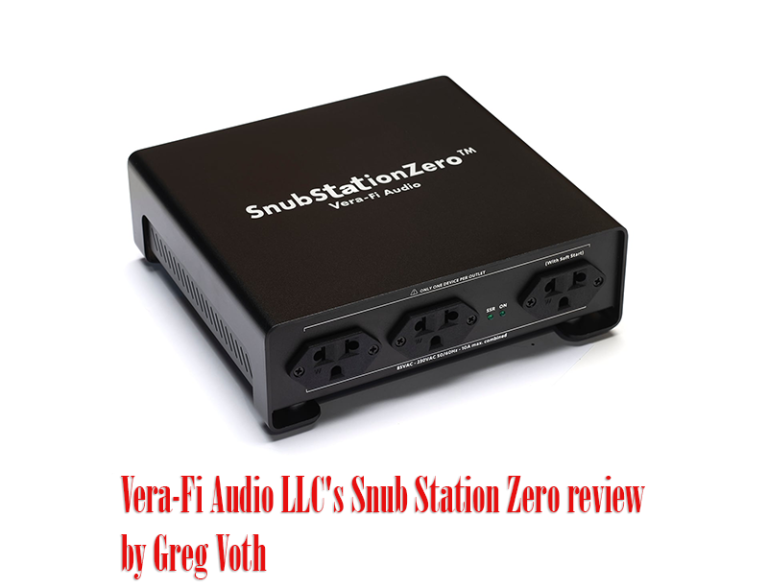
Stereo Times
The Snub Station Zero deserves an audition

Tone Publications
Distilled | Vera-Fi Audio Snub Station Zero
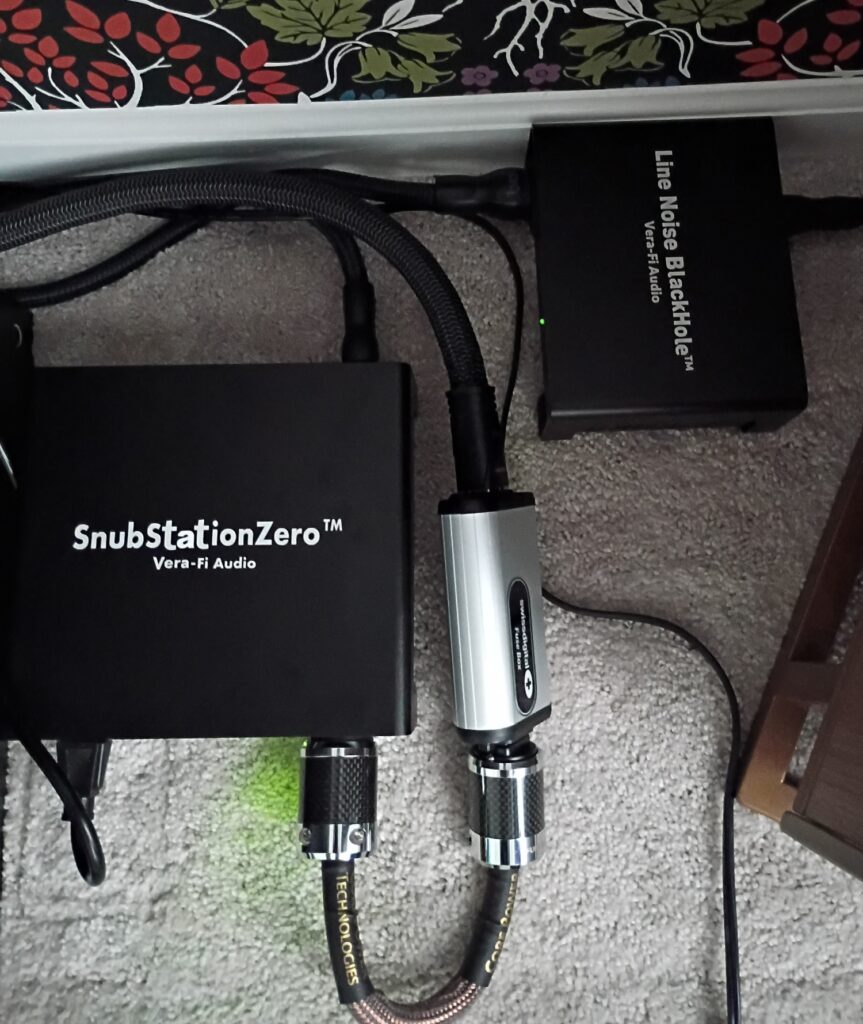
Positive Feedback
Serious AC Power Optimization that has Rocked my World!
Frequently Asked Questions (FAQs)
Where can I find Vera-Fi Audio warranty information?
You may find information about warranty here.
Follow Us!
Subscribe to our mailing list for insider news, product launches, and more.
- Choosing a selection results in a full page refresh.
- Opens in a new window.
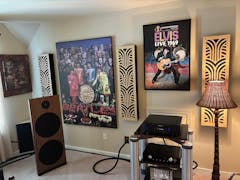
I have mine for a week or so; I have more on order, including the Snubway. But just this one unit has made an impact for the positive, so I am hoping to build on this. It is outlet d, and depending on which outlet it is plugged into, the results can vary, depending on the outlet position in the room. I put my in the Garage by the 1st AC outlet n to the fuse box after reading on that would be a good place for one unit, and they were right, right away the TV Sound bar and the 3 subwoofers connect sounded more dynamic, and the sound was more natural and with more body, what surprised me was on the 2nd level where my Stereo is it made a positive impact there also, I went down and unplugged it and went up and listened again and there was a drop off in presence, body and weight to the music as well as lacking the detail, piano is what I used with a stand up bass, to keep it simple, all sound more real with the one unit plugged into the outlet by the fuse box, so one is staying when I get the others I will built from there and see the extra ones impact, Mark is going to send me a package that he feels will work best for my system, Mark been great even took the time to call me to answer some questions on his products and which would be best for my needs. So try different outlets, let the unit burn-in for a week or so, the only time it hurt the sound was when I put it in the outlet before the Core balanced line conditioner; those two did not play nice together at all, lost mid-bass and bass, sound was thin, but that was the only time, I will try a Snubway there when I receive it. A good product, give it a try.
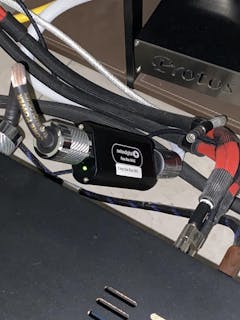
Really good uplift in soundstage, tonality and dynamics! No doubt about it or placebo!
The sound feels more pure!
At around 300 hrs like clarified by mark , the effect becomes very obvious!
I will probably go one for amp and one for streamer .
Bravo!
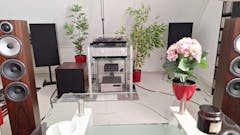
I've recently replaced my B&W 705 S2 standmount and B&W ASW608 sub by a new B&W 704 S3 floorstander. Incredibly good speakers, especially considering the price. The dual woofers reach down to 48Hz, but I still missed that last octave. I was looking for a suitable REL sub but after seeing so many good reviews about the Vanguard Caldera 12" Active Subwoofer I decided to give it a try. I thought it would be difficult to get one in the Netherlands. However thanks to Ace from Vera-Fi, he managed to do that; my sub arrived on location in 11 days. The price-performance ratio is out of this world. I thank Ace for all his efforts and Vera-Fi for an incredible deal.
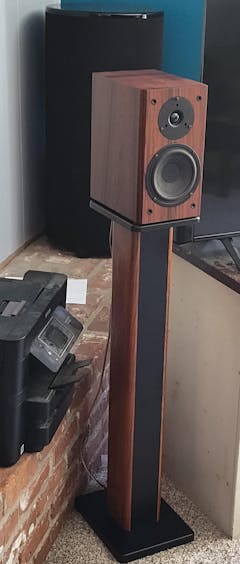
I bought these because I have been in love with Rosewood veneer since I first saw it as an extra cost option for some $5000 speakers in the '90s. Never expected to be able to afford a pair of Rosewood veneered speakers, but then found these for under $300. I pulled the trigger, ASAP.
When they arrived, I gave them >50 hours of 85dB in room playback of the radio with them facing each other under a comforter and wired out of phase to damp down the noise. After this, I gave them a listen. Beautiful, and they sound spectacular for their price point. I felt like I won the lottery; a scratcher, not the PowerBall, but still :) I was used to a bookshelf pair w/ lite mid-bass response and slightly "crisp" highs, and these (in direct comparison) had excellent mid-bass response and are just a bit laid-back in the very highest registers to my ears. I use them with a 500-watt RMS ported 12" subwoofer crossed over at 100Hz and get good output from them with an 80-watt per channel RMS amp. Like easy, no strain, >90dB at the listening position 12' away kind of "good output". For movies, tv, and music. Plenty for me.
If you like beautiful speakers, good sound (though not detail monsters like the AMT-tweeter based speakers I have in the bedroom), and spectacular value don't be afraid to pull the trigger on these Vanguard Scouts. Just please don't expect "giant killing" sound quality for under $300, and I promise you'll be happy with your purchase.
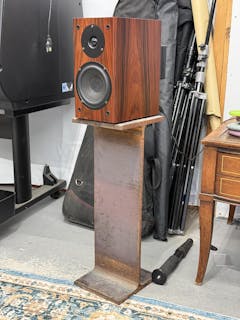
I’ve never had good speakers to listen to music on, so this was a big leap for me. I bought the Vera link combo and the 10” caldera to go with them. Mark has answered every question of mine personally and he advised that I connect the vera-link to the high pass input and then out put with some cables to the speaker and it works like a charm! Even though I am listening to music through my bluetooth on my iPhone, it sounds absolutely amazing!!

Excellent built quality, a ported sub that sounds closer to sealed sub and for only 348 euros? Insane but true, the Caldera 12 will sound just as good in my room for music or home theater, i cant recommend this sub enough! Go dual for bombastic room filling low notes imo. The only gripe i have is the auto on off which turns the sub off after only 10 seconds, i would recommend at least 1+ minute of inactivity to turn off so lets hope they boys in the lab will sort this out on the next batches! Excellent job Vera Fi team!

"First, I'd like to thank **Mr. Ace**. He was a great help with the delivery.
The **SnubWay - Noise Defender** has enhanced the audio system. A new level of sophistication has been added to the system, which was previously a straightforward 'Main Stream' setup.
Firstly, I feel like the **soundstage is wider**.
And I feel like it has captured the **subtle vibrations and noise**.
Frankly, I had been briefly tempted by Chinese-made products due to their price advantage.
However, **vera-fi-audiollc** clearly demonstrated the **technical gap** between those products and this one.
Thank you."

This is my first Hi-fi set of speakers I have ever bought. Before this, I listened to BOSE speakers.
WOW.... what an upgrade these Vanguard scout speakers are!!
I had to wait a couple months to get my order (because of tariffs), but Mark and his team were really amazing at answering all of my questions and updating me with the progress of my order.
I ordered the Caldera 10 sub, vera-link amps, and the scouts and Mark helped me to understand how to plug the vera-links bluetooth amps into the subwoofer through the high-pass input and output through the high-pass directly to the right scout speaker and it works like a charm! I couldn't be happier!
You will see two pics in my review of the back of the right vanguard scout speaker, because I wanted to show you that if you have to peel the velcro off of your speaker and place it elsewhere, it doesn't leave any residue to clean up! It's not a huge deal, but it certainly made my life easier.
I am a fan for life and will be ordering some of the new things they are working on in the future!

I purchased three Caldera 10's to go with my three pairs of Scouts. I love them, so I purchased 4 more to get small rooms 2.1 & large rooms a 2.2. I love speaker systems but I haven't had a good set up for years. I looked into this for months. I didn't know what my sound system was missing till I got the lower end filled in.

Great speakers, right in my budget. I purchased one pair, broke them in, loved them, and then purchased 2 more pairs. I had the option of ceiling speakers but bookshelf sound so much better. The Scouts allowed me to get great sound and budget. I have them in several rooms now. 2.2 in the main rooms and 2.1 in the small rooms. When connecting a Caldera 10 it was suggested to put a HPF 70h on the Scouts. I haven’t been able to find a good low cost 70h, closest so far is 80h $25. I purchased (3) pairs of Scouts and (7) Caldera 10. So HPF is important to focus more on the mid and high’s. Really really like Vera-Fi Scouts and Caldera’s!!!

